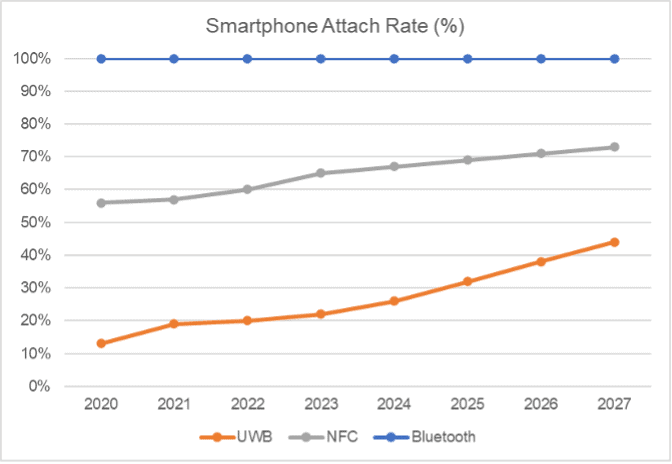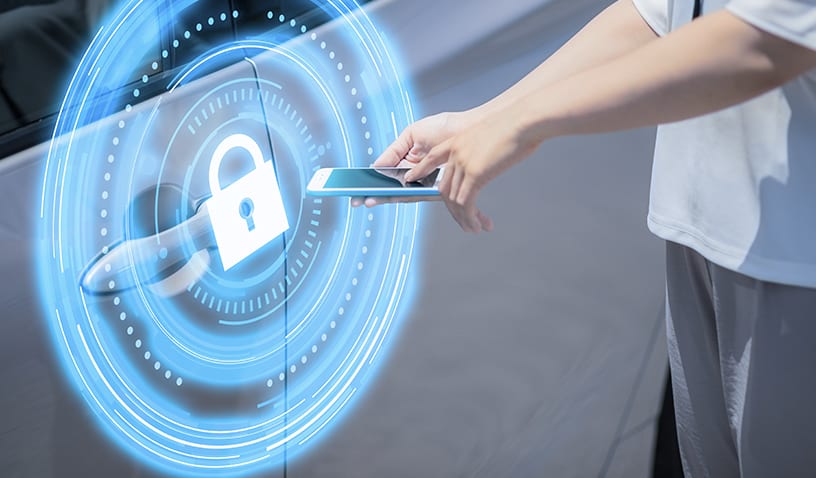UWB – Hype or Here to Stay?
By Yuka Muto
June 6, 2023Ultra-Wideband (UWB) has been gaining popularity since major smartphone makers adopted it as the next-generation, indoor positioning wireless standard, starting back in 2019. Since then, there have been flurries of product announcements, such as UWB tags to assist finding lost keys, and news of novel applications, such as real-time ball location tracking at FIFA World Cup 2022. However, the question remains whether UWB is just hype or here to stay as a default wireless standard like Wi-Fi. We will explore the potential of UWB technology in mission-critical applications such as keyless car entry and digital payment, and the challenges it faces in wider adoption.
UWB in Keyless Car Entry
In 2022, Car Connectivity Consortium (CCC) announced that it has adopted UWB as a complementary technology to Bluetooth® Low Energy for secure, keyless entry in its Digital Key Release 3 specification. While Bluetooth® Low Energy-based key fobs and apps have been widely adopted, concerns about possible relay-attacks have been raised. In a viral video, a Tesla was remotely unlocked and driven off with a laptop with an attached Bluetooth® relay device, and it was explained that this security vulnerability can affect any Bluetooth® Low Energy-enabled keyless entry vehicles. UWB, which relies on its nanosecond pulses to provide centimeter-level accuracy distance measurements, can ensure that the signal is coming from a legitimate, physically-present source, not from a boosted, relayed signal. With UWB providing added security, Bluetooth® Low Energy and UWB can work together to provide a reliable and secure keyless entry for ever-security conscious automotive industries.

ABI Research (2022)
UWB in Wireless Payment
As the smartphone attach rate keeps rising, UWB is also being considered as an alternative or complimentary technology to Near Field Communication (NFC). Contactless payment has been steadily gaining acceptance, as more smart devices such as smartphones and smart watches have been shipped with NFC, now reaching more than a 50% attach rate in smartphones. COVID-19 in the last 3 years has accelerated the adoption of contactless payment, both NFC- and QR code-based, to avoid handling of physical cash and credit cards. UWB can advance contactless payment even further; UWB can revolutionize the payment industry, enabling consumers to pay for the groceries and unlock their cars, all without taking out a credit card, a key or a phone. With its centimeter-level accuracy, UWB can ensure you are paying for your own groceries, not for the person in the next checkout lane.
Bluetooth® and UWB
While UWB provides unparalleled accuracy and security for mission critical applications, Bluetooth® is still a practical option for some location-based services. Bluetooth® SIG is exploring new ways to improve distance measurement accuracy and security such as Channel Sounding (CS), previously known as High Accuracy Distance Measurement (HADM). In CS, Bluetooth® signals of two or more frequencies are used to calculate the distance between two Bluetooth® devices based on the observed relative phase differences of those signals. Unlike the Received Signal Strength Indicator (RSSI) method, previously used for Bluetooth® distance measurement, which relies on the relative power level of the received signal, it is less susceptible to relay attacks and can provide better, meter-level accuracy. Such accuracy could have been previously achieved with multiple antennas, with triangulation, but the single-antenna implementation of CS is attractive in terms of reducing hardware cost. Furthermore, one can use a metric called Normalized Attack Detector (NAD) in Bluetooth® Channel Sounding to identify and quantify sudden changes in the RF environment. Comparing the received packet against the expected packet signal, a NAD metric value is calculated as the probability that an attacker is present. Given its 100% attach rate to smartphones, when CS is finalized and adopted, it will likely enable many real time location services (RTLS) that require distance measurements within a few meters, such as indoor navigation, asset and personnel tracking. However, UWB will likely continue playing the primary role, for mission critical applications that demand better accuracy and security such as contactless payment, keyless car access, and digital hotel room key.

Challenges Faced by UWB
UWB’s 500 MHz or wider bandwidth inversely produces the nanosecond pulses that uniquely deliver the unprecedented distance measurement accuracy. However, the wideband width also leads to more complexity in the design and higher power consumption. It is more regulated for emission limits as it operates in the licensed band per Part 15 of FCC Rules than its narrow-band counterparts that operate in the unlicensed 2.4 GHz band. To mitigate these challenges, location and security applications will keep relying on some of the initial discovery and synchronization on narrow band wireless standards such as Bluetooth® to offload communication, reserving UWB usage for mission-critical distance ranging. Rather than competing for convergence, wireless standards must collaborate with each other in providing the best user experience for a given use case. In other words, we will likely see more, not fewer, wireless standards integration in smartphones and cars, and UWB will likely become the main source of the precise, secure location-based communication. For that, UWB devices’ utmost priority will be accuracy quality.
Conclusion
UWB technology has the potential to revolutionize mission-critical applications such as keyless car entry and digital payment, providing unparalleled accuracy and security. While other wireless standards like Bluetooth® remain practical options for some location-based services and a critical partner in offloading traffic, UWB will likely play the primary role in security-centric applications. Despite some of the challenges UWB faces, collaboration with other wireless standards can ultimately help overcome these challenges to provide the best, integrated wireless experience for users.
Categories
Subscribe to the LitePoint Blog
Related Posts
3 for 3: UWB, what is it and how does it work?
June 6, 2023
UWB Certification: Why it Matters and How it’s Tested
June 6, 2023